For our previous trips see Travels with Theoduff
Its 2023 it must be the Europe by train trip! We will be posting as we go and invite you to travel along with us too.
It’s over and we are home! Just a few extra dot points!
- Don’t wear your best dangly earrings on long plane journeys! Make sure you have both earrings in your ears every time you go to the loo on the plane! Better still, wear no earrings or only ones that have clips to keep them secure! It is very hard to find small slithers of wire in a dark and cramped plane seat space. Yet another single earring has joined my growing collection of unpartnered jewels!
- Always take a scarf when flying! Helps to keep your neck warm and snuggly especially if someone close by has opened up the air nozzle. Planes can be pretty cold. See first dot point – scarves and blankets and dangly earrings may not be a good mix!
- No, you don’t need to take all those clothes, just in case! We took ‘extra’ clothes in case it was cold and those were the only ones we wore in six weeks, apart from a day or two when Tony risked wearing his shorts. We could have managed with just one suitcase between us after all – which would have made getting on and off trains and negotiating escalators and all those staircases so much easier, especially for the person who did most of the suitcase wrangling!
- There will always be someone’s washing machine you can use on your travels – a friends, relatives or the local laundromat! Probably a lot cheaper than getting the hotel to do it for you in Europe. See dot point 3 above – no one else knows if you have worn the same thing for 2 or 3 days running!
- Take good walking shoes! The streets of Rome and other older cities are paved, not with gold, but with cobble stones which call for flexible rubber soled shoes for your walking comfort.
- You rarely need to use cash! Credit and debit cards are accepted nearly everywhere except perhaps the snack caravan in St Peter’s Square in Rome. Minimum charge to pay by card in Paris taxis is Eu10. Consider getting a card account which doesn’t charge excess foreign exchange fees. Don’t forget to let your bank know you are travelling overseas …. otherwise, you may find your card doesn’t work after all!
- Credit/debit cards/phone can be used to tag on and off for tube/bus tickets in London and other cities. This often means much cheaper travel than purchasing individual tickets via the ticket machine. However, in Rome, you get charged extra for using your card to buy tickets from machines. Do the sums and consult the local travel apps.
- Tipping – sometimes service was added to the bill as a %, other times you could add a tip if you wanted to as part of the card transaction. Most times we didn’t tip and weren’t hassled at all.
- Medications –stock up on essential meds to last the trip. I carry these in my backpack to show at airport security and to make sure I have them with me in case bags go astray. Take the prescription or the label from the box with you too so you can prove it was prescribed, just on the offchance that someone asks.
- Mobile phone plans – check out alternatives to the global roaming charges of up to $10 a day charged by Big Phone which would add up to a lot over six weeks of travel! We set up Felix accounts which worked for us – make sure you read the fine print re coverage etc. Whatsapp is good for free messages/international calls too and most hotels and family and friends have WIFI to share!. If you do get a new phone number for the trip, don’t forget to work out how you will get the access codes that banks and other organizations send you to do transactions/access your email etc. And … remember to use aeroplane mode so your phone isn’t constantly updating itself and using up your data allowance.
- Train travel was an excellent way to see Europe and the Eurail Pass was well worth it. Trains are very well patronized and you need to reserve seats on particular long distance trains at small additional cost – the transport offices at main stations are helpful in booking these. We had a base in each country we visited and used local trains to go to other cities/places of interest – all using the Eurail Pass.
- So glad we used a travel agent who picked great hotels and organised flights for us! Thanks Alex!
Happy travels !
Episode 5 Scandi Solitude
Conceding a direct flight to Bergen from the UK would probably have been much easier, we spent the day and well into the evening reaching our eventual destination of Finnis, on the island of Bomlo, about 110 kilometres by car south of Bergen, flying via Oslo and a fast ferry which runs four times a day. Hundreds of fjords and islands are literally strewn along Norway’s western coast where settlements and farms have survived for many centuries. With over 200 days of rain and in excess of 2.5 metres falling per annum, this is the wettest part of Europe.
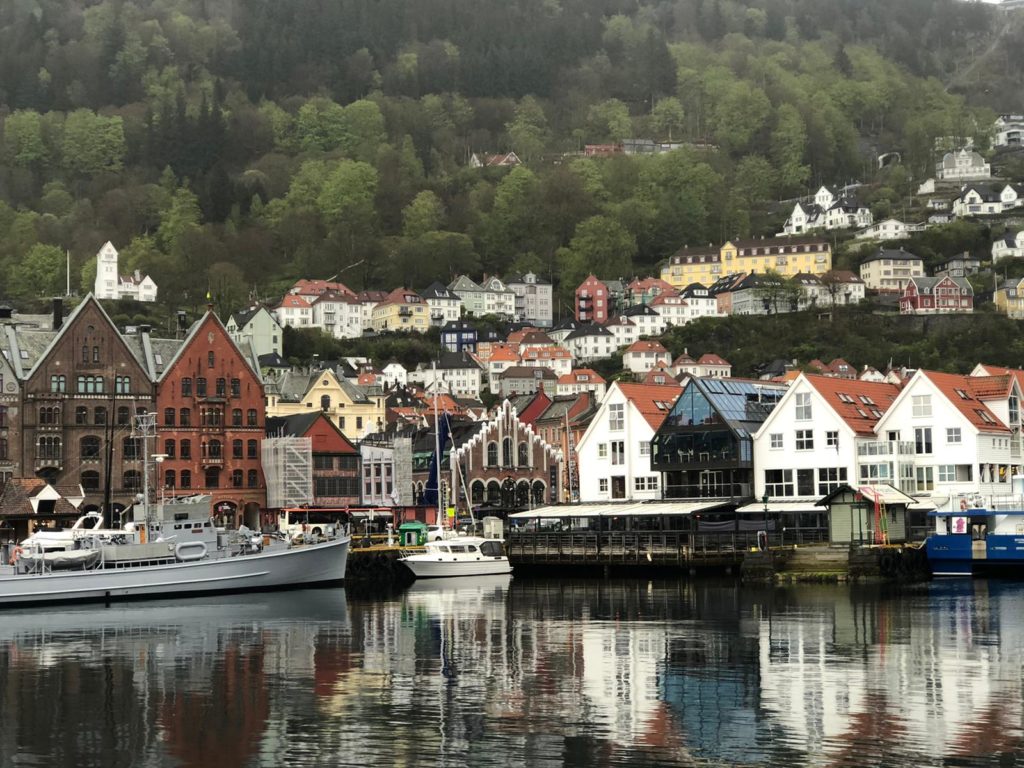
Our hosts Tony’s cousin and her family live in a typical Norwegian timber clad one-story house, well insulated and kept at a comfortable 20degC inside. Set next to a sheep farm and amongst other sparsely spread family homes on acre blocks it seemed a world away from high density and fast paced England. The island we’re staying on is connected to other islands both larger and smaller, north, east and south by bridges, ferries and some tunnels. The roads are two lane or even smaller, winding and circuitous – passing buses and trucks can be challenging as we found out on our first driving expedition, puncturing the rear passenger tyre in a large pothole while giving a truck space to pass us. However, drivers are generally courteous and patient and ever watchful in case something big comes towards them just around the bend! The top speed is 80km/hour on most roads.
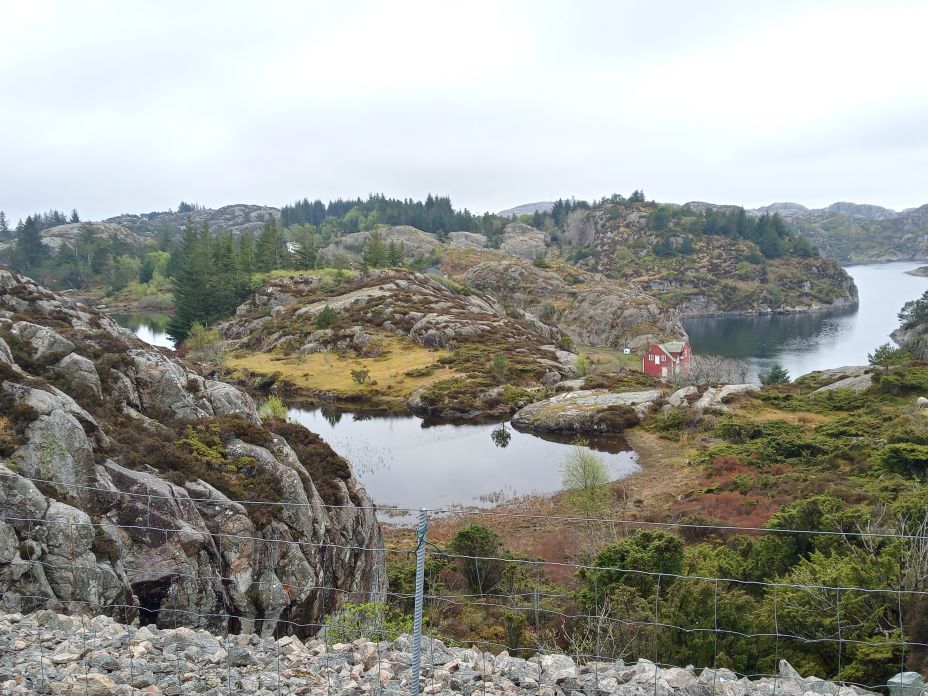
The weather cleared on our second day and what a difference some sun and no rain made. The coastal islands and fjords have been farmed and fished since the Iron Age with the tiny farms inhabiting cleared forest and the little flat land there is. We had some spectacular scenery to savour, fishing villages clinging to the shore, tiny huts painted bright red and yellow dotted amongst the rocky mountainous terrain. Narrow, one car wide bridges connect to the small outer islands where only hardy sailors and fishermen would have lived before roads were built.
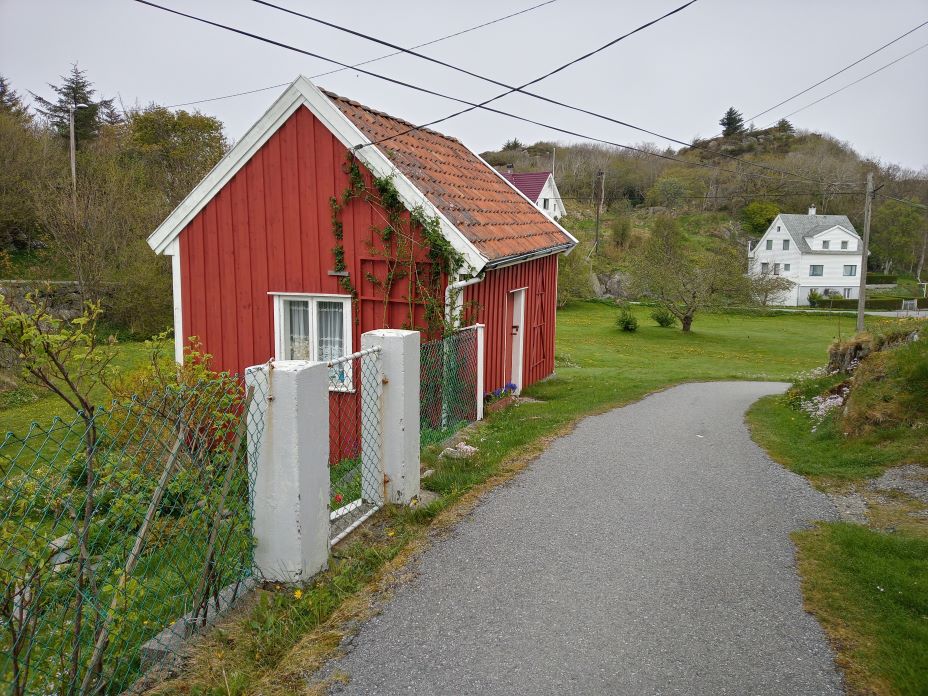
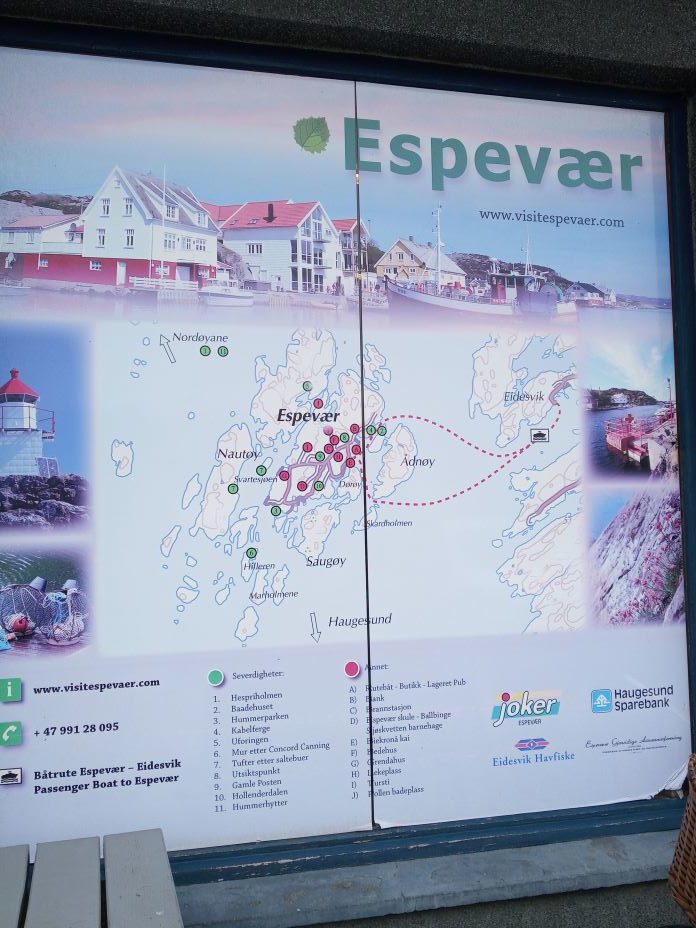
We took a picnic to a tiny island, Espevaer, only accessible by boat, where time has almost stood still. With well- tended gardens and freshly painted wooden houses built early last century, it is really a museum to the fishing community. It is hard to believe now but it was a thriving trading port 200 years ago with a prime location at the western entrance to the waters of Vestland and Rogoland, with a series of four long attached sheds at the Hummerparken housing up to 20,000 lobsters during the lobster season. We also worked out how to use the cable ferry clanging across the harbour at some speed and taking care to watch out for oncoming boats before we pressed the start button!
The landscape on the islands and around the fjords is very reminiscent of New Zealand – bright green and damp, rocky and very hilly, dotted with sheep and conifers. However, the many centuries of human habitation and taming the land to man’s needs has of course drastically altered the natural landscape, any cleared area has been cropped and the farm animals leave their imprint.
Touring with our hosts on a sunny warm spring day on electric-powered ferries and driving through kilometre long tunnels with few other vehicles on the road, we were left awestruck at the sheer physical beauty of the fjords and mountains. Plenty of snow remains on the higher peaks of the Hardangervidda and the vastness of the deep Ice Age fjords and bays has to be seen to be believed. It was Confirmation weekend so few children and parents were apparent other than outside churches – the children dressed in national costume with their parents in their Sunday best.
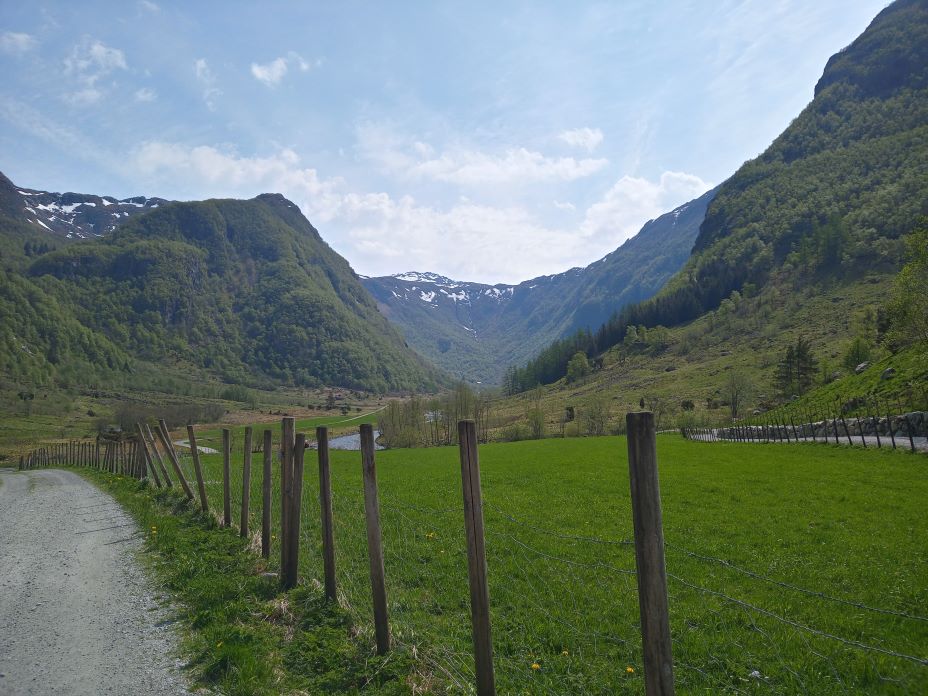
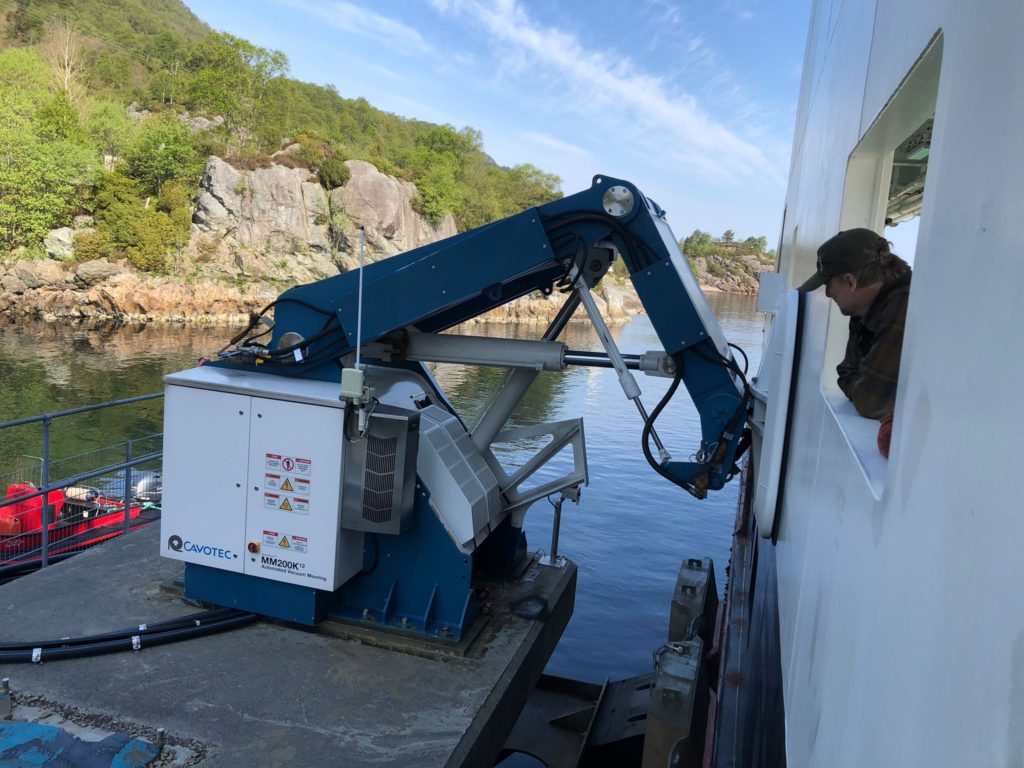
ferry
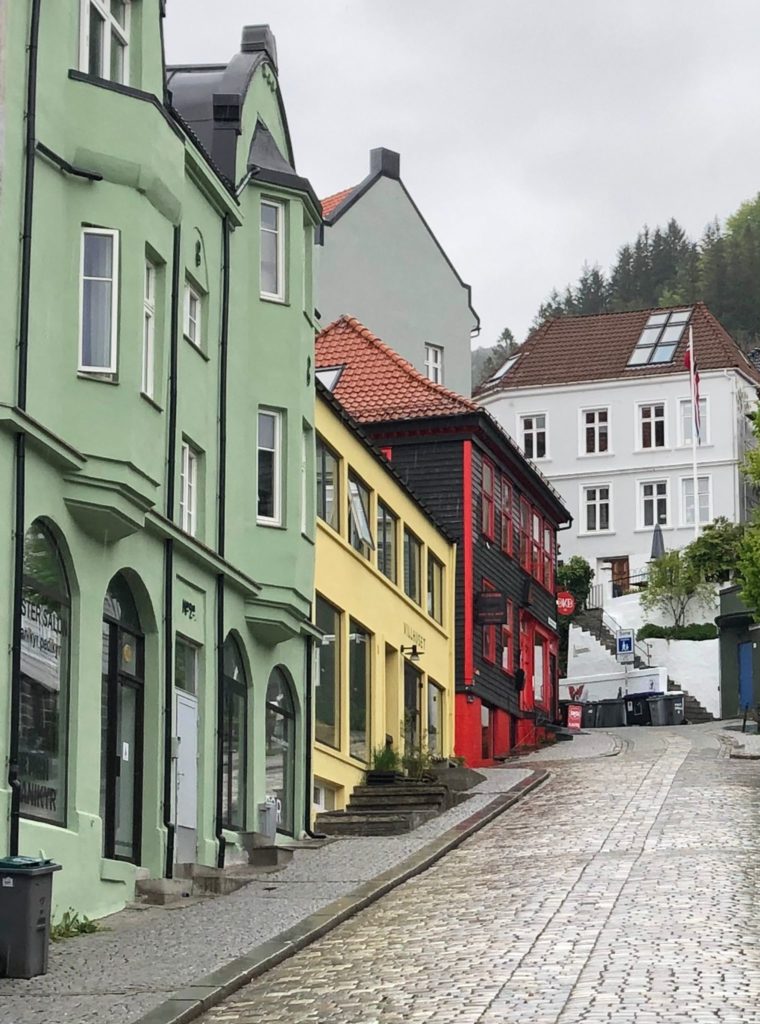
The old Hanseatic city of Bergen was explored on foot on a fairly cold somewhat damp day. Surrounded by 7 mountains it supposedly looks spectacular in full sun! We weren’t disappointed when we climbed above the city centre in a funicular railway and saw the spacious glaciated harbour spread out below. After wandering the narrow streets of the UNESCO World Heritage Listed, old Bryggen, we retreated to KODE museum as the weather deteriorated and spent a couple of hours mainly with works by Munch and other Norwegian modern artists. We have spent several hours this trip in Rome, Lucerne and Bergen perusing a number of collections donated by their owners for public viewing including works by Picasso, Paul Klee, Munch and others. The new Oslo Munch Gallery houses the famous “Scream”. On reading the latest Jo Nesbo book, Killing Moon, this building doesn’t appear to be universally popular with its neighbours as it is mentioned several times already and I am only half way through!
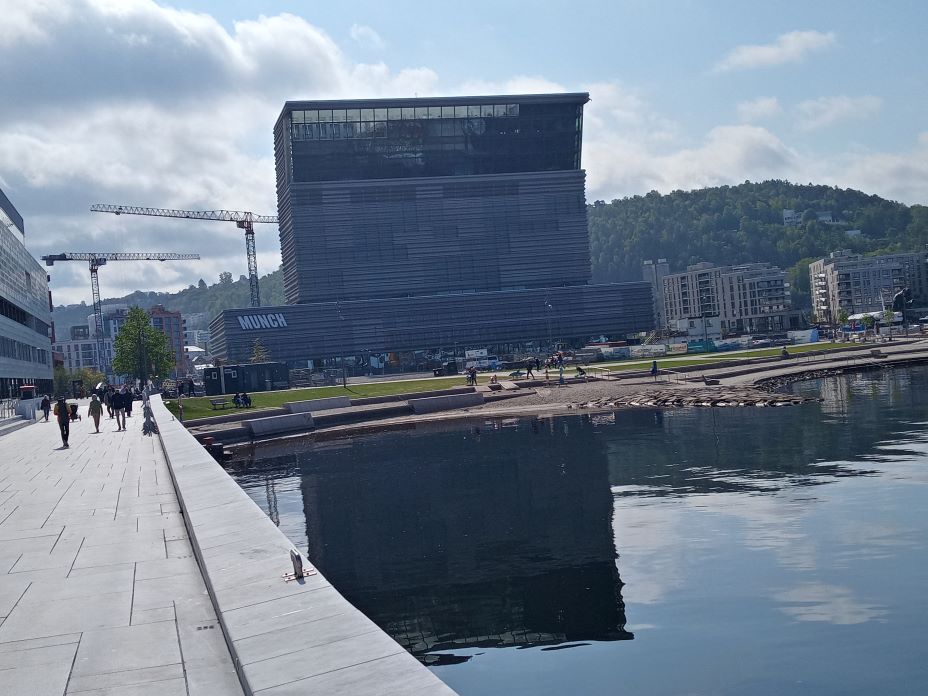
The 17th of May is Norway’s national day, celebrating when the country’s constitution was signed in 1814 and it is celebrated everywhere in the country. Everywhere was decked out with national flags, many people were wearing national costume and the day includes children’s parades and festivities with big feasts and, in Bergen, groups of marching drummers. We watched some of the preparations before boarding our midday train to Oslo.
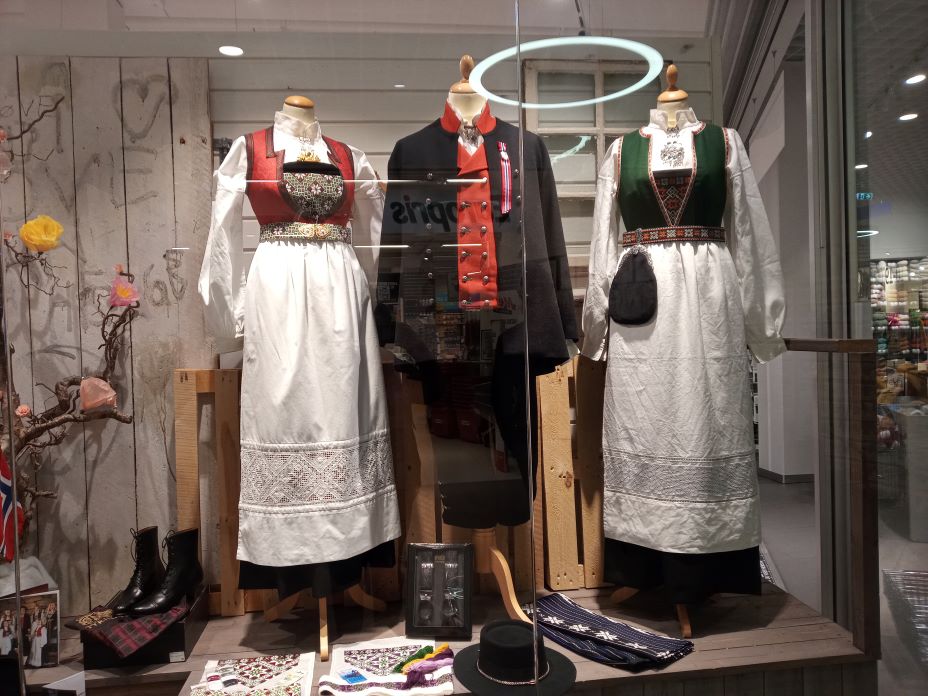
As keen Michael Portillo train trip watchers, we wanted to do the 7-hour journey to Oslo which has 22 stops, 182 tunnels and climbs to 3600 metres through the mountains before descending to sea level at Drammen, then onto Oslo. This was definitely a highlight of our six weeks because we almost had the train to ourselves as it was a public holiday and we were able to revel in the amazing scenery, dodging from window to window to take it in and take lots of photos too! Still deep in snow in the higher parts, with villages that are really only connected by the train, small ski lodges near the trainline and rivers still frozen over. We passed by fjords as we descended and then with flatter land, cropping and dairying took over.
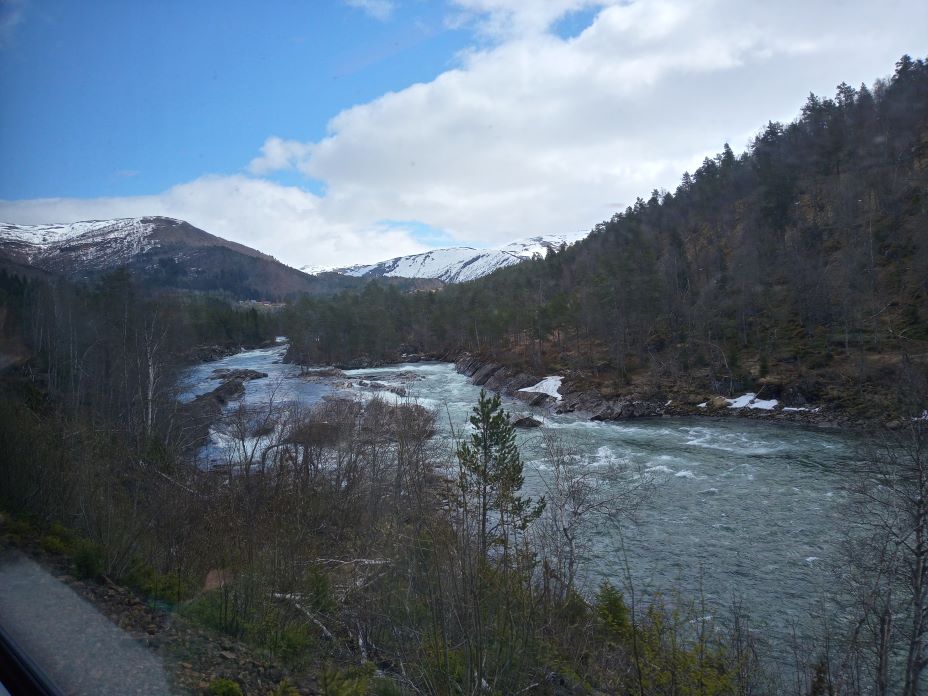
We stayed with a young family about 30 kilometres north of Oslo in Nittedal. In a change to our previous accommodation, they have a newish three-storey wooden townhouse, part of a new suburban development. The company of young children was a welcome change too, playing with toys, reading stories and going for a walk around the settlement. These new developments provide housing for those who may work in Oslo and want to live in the country with more affordable house prices. Each section has playgrounds and safe roads for kids playing on bikes and a sense of community too.
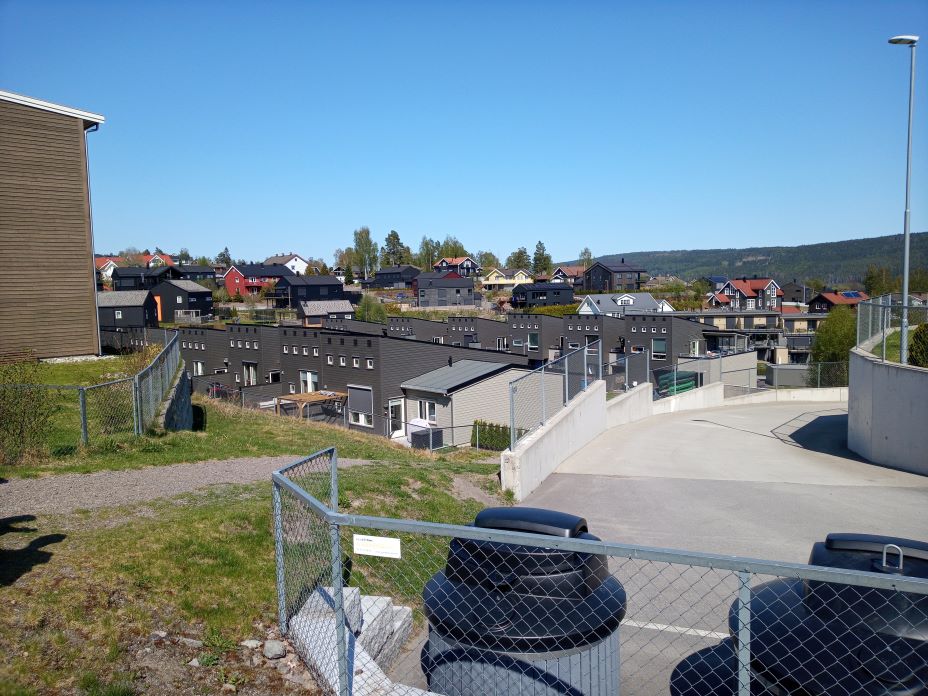
Oslo was only a short train journey away and on a sunny spring day we wandered from the station around and up to the top of the Opera House and then to Aker Brygge on the fjord for a 2 hour boat trip around the hundreds of islands. Oslo has scores of museums, but we decided to only visit the Kon Tiki museum, a tribute to Thor Heyerdahl’s expeditions and life in Bygdoy before catching a bus back near Karl Johan’s Gate. It is an easy city to navigate with plenty to see, we didn’t really do it justice in one day.
We loved being in Norway and felt very comfortable with the culture and people. Although more expensive than Australia it is probably cheaper than Switzerland and with such amazing scenery it’s a country we’d love to return to and explore more.
Our next destination was Brittany in northern France where we visited Sally’s brother and family for a couple of days before flying home from Paris. The many seaside towns bordering the English Channel are very popular with Parisians who have huge houses along the cliffs that they only open up for a couple of months in summer. Long sandy beaches with tidal ranges that are some of the longest in Europe offer many holiday leisure activities and plenty of traditional Breton fare including crepes, shellfish and cider. Our cute AirBNB apartment at St Cast had a mesmerising view of the beach where you could sit and just watch the tide coming in and out.
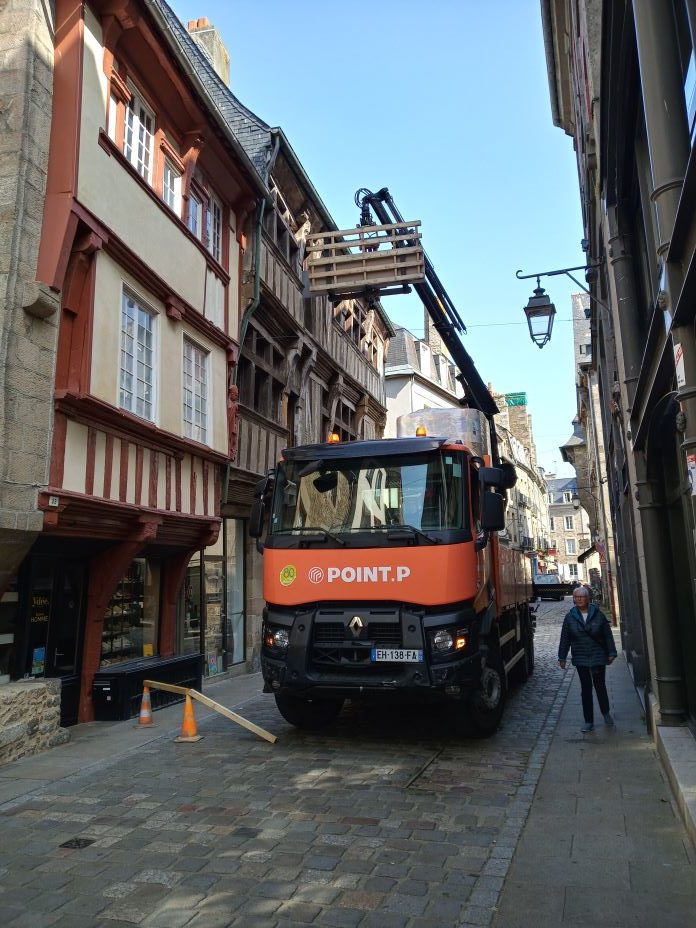
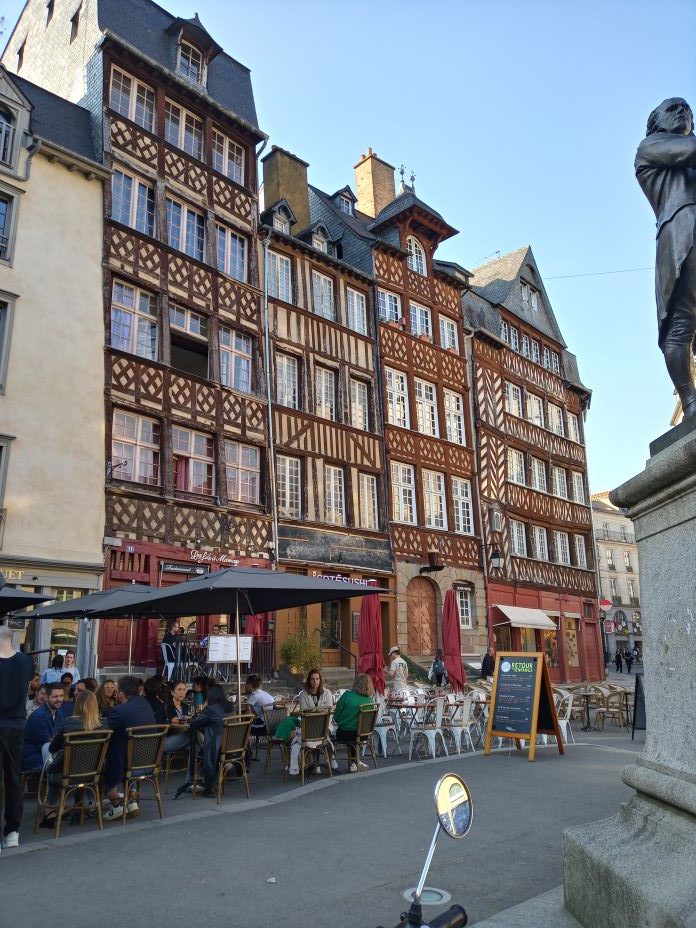
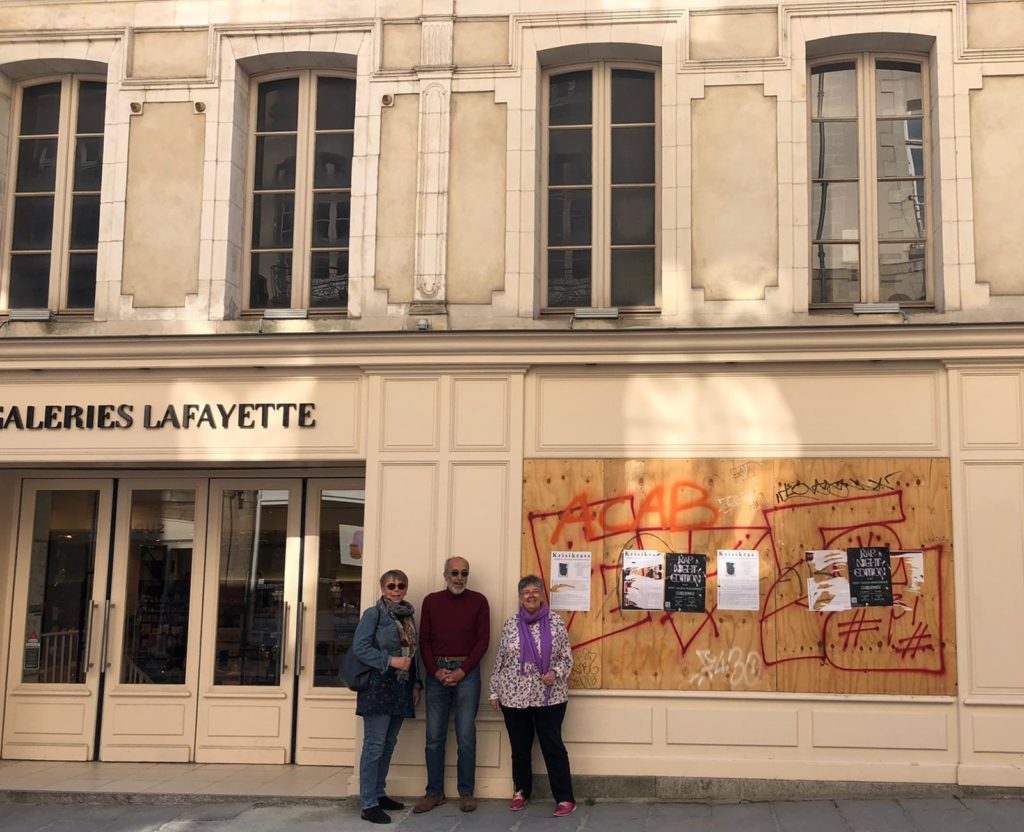
Wandering around Rennes city centre, the sight of countless boarded up shop fronts and windows astonished us. The “manifestation” a few weeks ago with thousands demonstrating against the Macron government’s increase in the retirement age from 62 years old to 64 (sacre bleu!) was evident everywhere. Banks, department stores, government offices in the centre of the city – anywhere deemed a national target – windows had been smashed. Mindless violence with no real prospect of forcing any change; only because the French people just don’t like any alteration to their status quo or the government telling them what to do. The French government haven’t balanced their books in 57 years so an increase of two years in the retirement age is likely to have little effect on the exchequer.
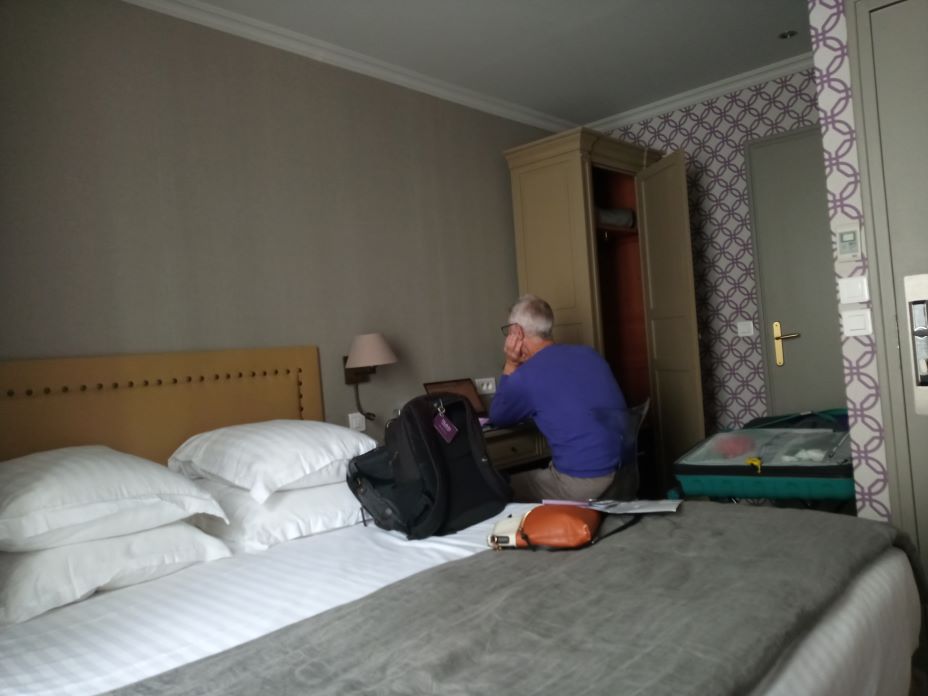
Catching up with family and friends across the UK and Europe has been very special and we are already thinking about another trip in the future…. However, returning to Perth will not be the anticlimax it often is after an overseas holiday as we await the arrival of not one, but two grandchildren in the next few weeks. Another holiday will have to wait …
Episode 4 – Back to Blighty
Our first experience of the Eurostar was that it’s efficient and comfortable although it’s far from the bullet train [the Shinkansen] in which we zipped from Tokyo to Osaka in 1982. We got to St Pancras in just over two hours and were soon out into the London streets. Pulling out our Eurail phone app elicited raised eyebrows and confusion with the British Rail staff at London Bridge station, eventually we were allowed to board the Orpington train amongst the mid-afternoon hordes. Staying with Sally’s cousin and family in a suburban house was a novelty for this trip as was the conversational catch up in English. We were made to feel immediately at home, especially later when treated to sharing a special birthday dinner.
Left to our own devices as our hosts and their offspring earned a crust and an education, we took up an offer of free entrance to nearby Down House, Charles Darwin’s residence for 40 years. Combining a museum which details Darwin’s achievements with the marvellous garden he created and used for experiments and to feed his family and household. We enjoyed a few hours in the Kent countryside. Interestingly, there was limited mobile and no wifi coverage there so the staff offered to phone for a taxi for us to get home.
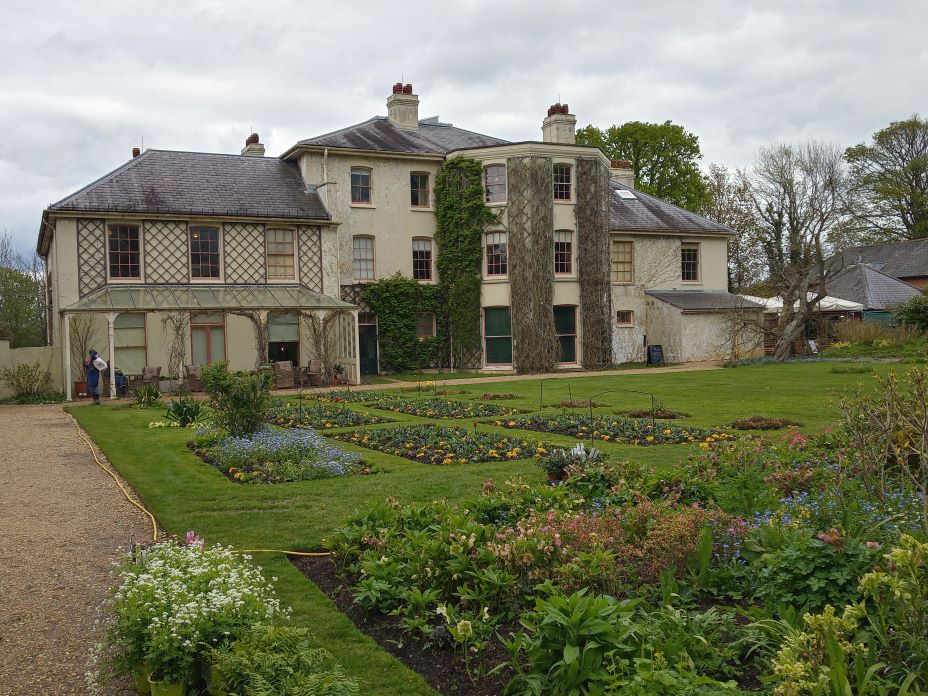
Our Orpington sojourn was on an estate built where a Canadian WW2 hospital once stood, in a modern three storey home with great views.
We ventured into London the next day to lunch with niece and nephew and to collect a rental car from Heathrow. Walking in the bright sun from St Pancras to Piccadilly, we were struck by the restrained Coronation bunting and flags (for the next weekend) and the crowds on the streets. An Eid festival was being held in Trafalgar Square, the side streets seemed full of outdoor seats for cafes and restaurants and there was a distinct absence of vehicles – a congestion tax of £25 per visit means few people now drive there, a welcome change from the smoky polluted 1970s London that we experienced. We lunched in a wonderful underground space converted into the bustling busy Parisian-styled Brasserie Zedels with a small four-piece orchestra playing discreetly. Family reunions over lunch are usually too short as was this one, but we caught up on each other’s lives, nonetheless.
We took the new Elizabeth Line from Tottenham Court Road to Heathrow in clean spacious brand-new carriages for a surprisingly low tube fare of a couple of dollars. It seems to be a convenient way to get to and from the airport into London and to connect with other trains at Reading and central London too. Helpfully, we found in Europe and the UK credit/debit cards could be swiped on entry on public transport instead of purchasing specific tickets which often turned out more expensive – Sally was shocked at paying £6.50 for tickets to go three stops on the tube from St Pancras to London Bridge.
Hertz didn’t have a car for us of the type we had booked so upgraded us to an electric 4 door, Polestar 2LR SM. Only ever having briefly driven electric with a friend in New Zealand, this was a pretty novel experience. The first run was on the notorious London ring road, the M25, back to Orpington and it went smoothly with no hassles. We plugged it in on an extension cord and charged it up for the night and started to realise the trickle feed nature of residential recharging – over 14 hours plugged in we had topped up to just on 80% charge (from a starting charge of 60%) or about 210 miles (340 km).
Bidding farewell to our generous hosts we set off towards Highcliffe on the south coast near Bournemouth where we were meeting friends from Sally’s Weston-super-Mare college days. We had a great catch up over lunch (we had also previously travelled together to South India and Ningaloo and Karajini in WA) and later we had a wander along the beach path for an ice cream and a cuppa in the grounds of Highcliffe castle. Our friend’s flat on an estate of four apartment blocks was very quiet with direct access to the beach and not far to walk to the pub for dinner.
We headed west the next day aiming for North Devon but as we hadn’t recharged the car since London we needed to find somewhere. The recommended Zap-Map App suggested some nearby charging stations though not all are fast with some hotels and supermarkets limited to 20KW. So began a day of some frustration and some range anxiety as we learned that driving electric has its pitfalls with out of use charging stations, very slow stations at supermarkets and of course few fast-charging stations readily available to the passing novice EV driver!. Some required signing up, some downloading an app, some paying to join and some just needed a swiped credit card to pay (the best option). We found other EV users very helpful with advice re which cord to use and where the higher KW chargers may be. BP Pulse seems to be a good choice and you don’t have to join to use them. We finally found a 75KW charger in an out of the way place near a coffee shop that was just about to close and it took less than an hour to charge the car to 80%. In the end we reached Barnstaple, and Sally’s brothers residence, about dinner time after spending at least two hours during the day charging up. Most motorway services have charging stations too so you can take a break for a cuppa or lunch while your car charges. While we definitely spent less on charging our EV than buying petrol, due to using our hosts’ power on several occasions, it takes a bit of initial planning and use of google maps to locate the chargers in a strange land!
On the way south, we had stopped at Bovington Tank Museum where we wandered amongst the hundreds of tanks and read their stories. The drive through Somerset and Devon’s rolling green farmland on a sunny afternoon evoked many memories of our times living in and touring England, it is literally a beautiful country.
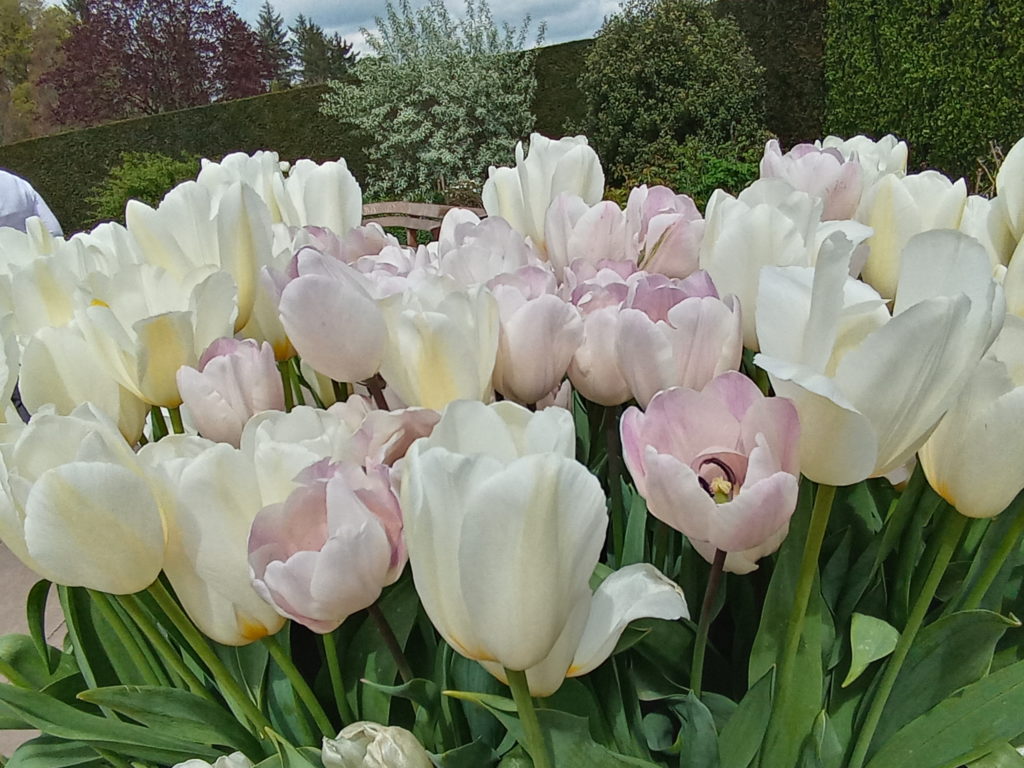
Our hosts were happy to accompany us to spend a sunny warm afternoon at the Royal Horticultural Society’s gardens at Rosemoor near Torrington. We hit roadworks and took another route via an almost one lane road between bountifully vegetated tall hedges and a couple of meetings with recycling trucks coming the other way which required some reversing/edging slightly off road manoeuvres to let them past, with those of us sitting in the back with eyes pinned on the road ahead unable to divert our attention elsewhere!! We lunched, had afternoon tea and wandered all around the garden paths, peonies and fuchsias were flowering and avenues of cherry and apple trees were out in riotous strength.
The weather held out the next day when we ventured north into Somerset and visited East Brent where Sally grew up and the last survivor of Sally’s parents’ generation still lives. Tales of family life in the post 1950s and of Frank and little Frank Woodward (grandfather & great-grandfather) farming and representing the village and environs on various agricultural boards were great additions to our family history collection. We visited the family grave sites in the village churchyard where we had been married in 1982 and then climbed up Brent Knoll which Tony has done on every visit to the UK since first visiting in 1977. The Knoll is an Iron Age fort with amazing 360-degree views to Glastonbury Tor, the Mendips, the South Wales coast, Hinkley Point nuclear power station and the Quantocks. Spotting the Knoll on the journey down the motorway from the north is always a special moment as it stands out proud on the Somerset Levels and means you are nearly ‘home’. The Levels are under sea level with several peat bogs and before being drained for agriculture were under water several centuries ago and are still prone to flooding after heavy rain.
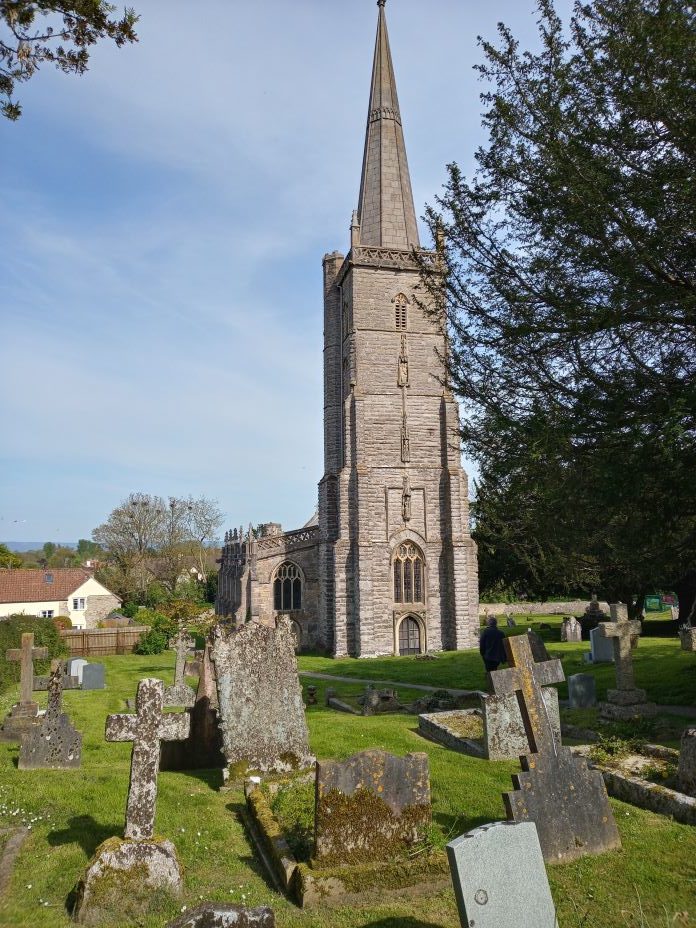
All good things come to an end and, with the southwest change, the rain arrived and hung around for the next three days. Farewelling Devon, we drove north past Bristol to Gloucester and celebrating the 50-year anniversary of being in Biling 1 (Bilingual Secretarial course) rendezvous with more of Sally’s WSM college friends. Decorated for the Coronation, we all enjoyed an afternoon and evening of catching up.
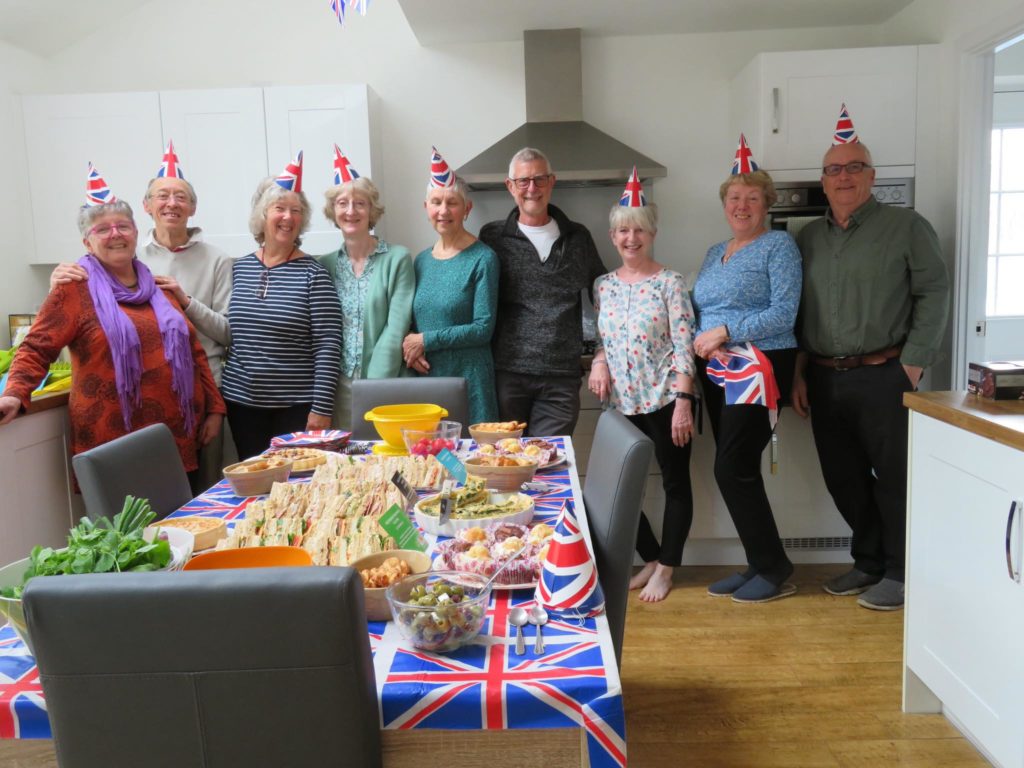
Coronation day was quite wet, and as we were not wanting to spend 3 hours watching the royal spectacle, we drove across the country to the Fenlands and Cambridge on fairly quiet roads listening to some of the festivities on the radio. Our hosts, Tony’s uncle and aunt had also not seen anything of the day’s events, so we were able to catch up on all our news without the regal events interfering. Living on the southern fringe of the city, our hosts although only 20 minutes’ walk from the major colleges are also just around the corner from the countryside so we were able to take advantage of this the next day walking in the sunshine.
After a week in the land of Sally’s childhood we were becoming aware of a real decline within British society since our previous pre-Brexit visit in 2016. Brexit has created fissures within communities, and it does seem to us that what people believed in previously is disappearing and the country is moving slowly backwards. Modern politics and the present government have greatly assisted this slide which probably began with the Thatcher government in the 1980s. We heard concerned tales of government ineptitude, lack of capital investment in the education and health sectors and environmental degradation of the waterways.
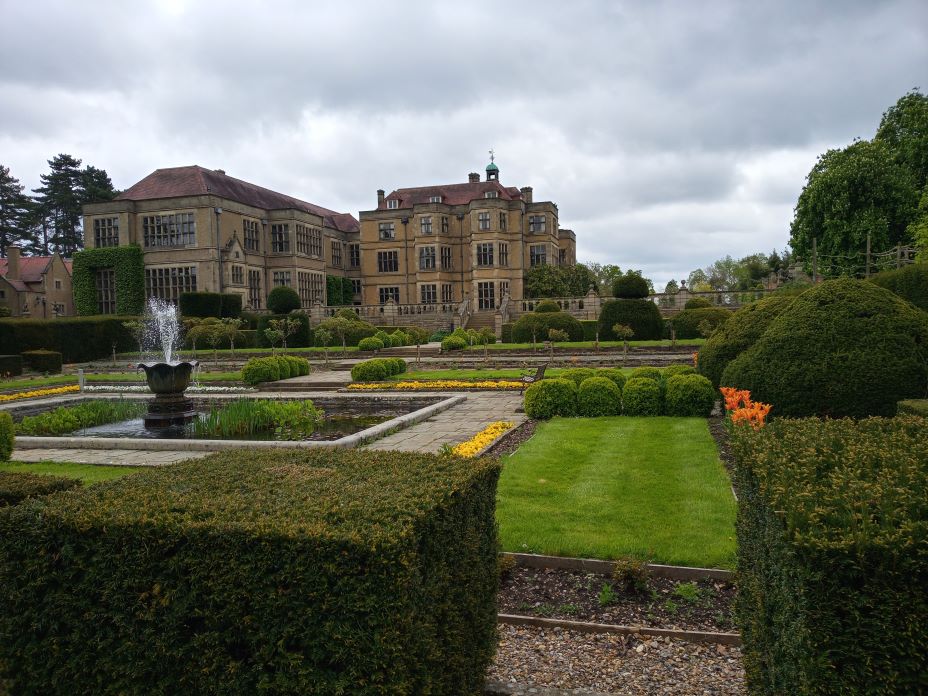
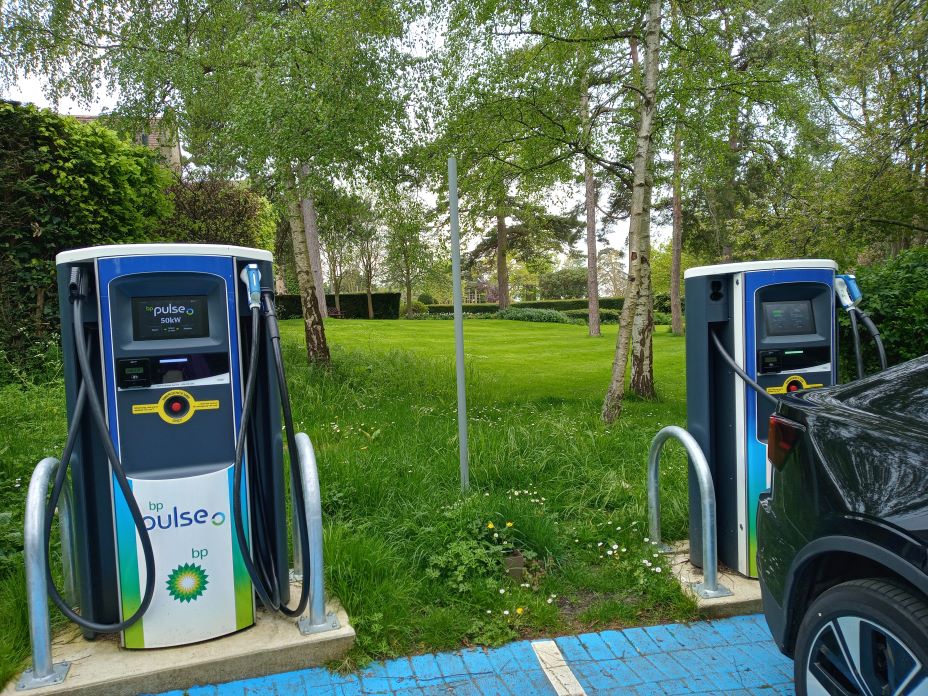
Heading south towards our English exit destination of Heathrow, we found the fast charger at a stately home/conference centre called Fanham Hall – an unusual spot for a fast charger with lovely grounds to walk around as we waited for the recharge. We stayed in Hertford for a night with another cousin in a residential redevelopment of an old hospital site. From London’s leafy commuter-belt, we left for Heathrow at 5:45 am the next day and were soon in a traffic jam on the M25, though we arrived at Hertz car drop off in good time and even had time for a leisurely breakfast in Terminal 2 – The Queen’s Terminal prior to our flight to Norway.
Episode 3 Antwerp and beyond
Our 11-hour, 950 km Eurail journey from Lucerne to Antwerp was as relaxing as can be with the only real hiccup being a slightly late arrival at Frankfurt. This necessitated a mad dash underneath 10 platforms to find our correct wagon. All four trains were close to capacity and at times reached 200 kph.
Nice warm weather on our first morning in Antwerp persuaded us to wander to the Shelde River and learn something of Antwerp’s rich maritime and mercantile history at Steenplein. When clouds and a strong wind brought a cold change, the cold stayed around for most of the next four days in Belgium. We visited the MAS Museum which gave us a very detailed understanding of the importance of Antwerp as a port over several centuries.
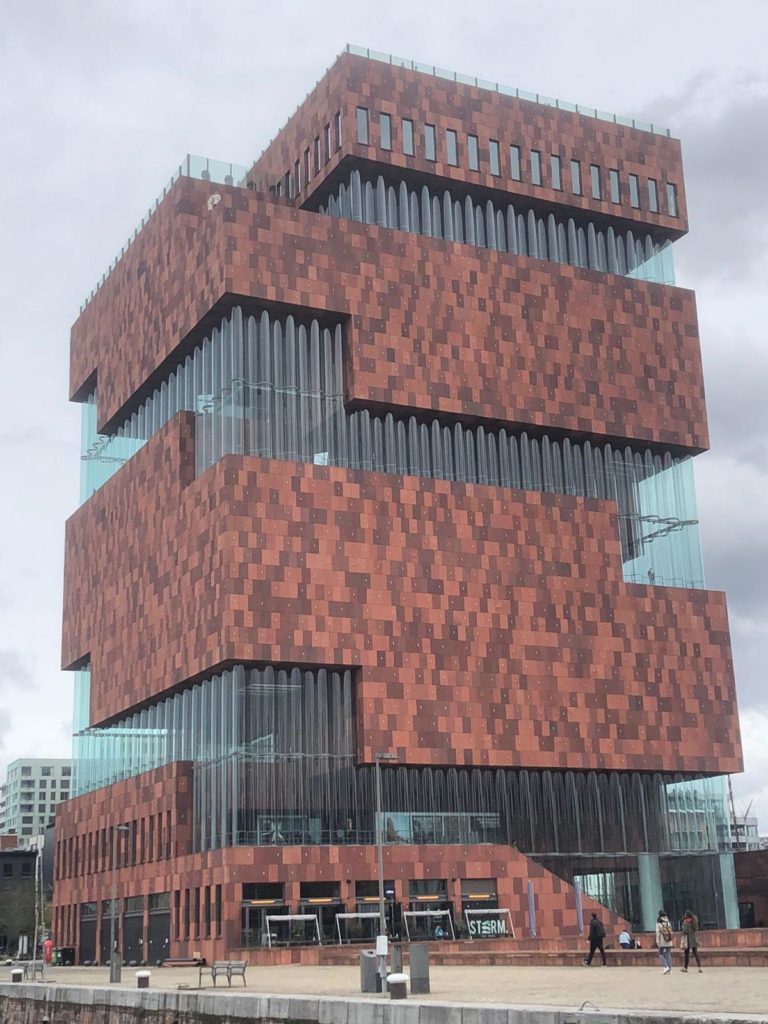
Encouraged to visit Bruges, a beautiful medieval city, we were not disappointed with this amazing UNESCO World Heritage site. We wandered around getting lost in the narrow, cobbled lanes even though we had a handy tourist map, marvelling at all the wonderful 15th and 16th century houses, cathedrals, bell towers and halls everywhere. With so many tourists visiting the city it is very organised with a free shuttle bus around the most popular areas and to the railway station.
Brussels is virtually the EU capital although no one will admit it, in the news the EU is often just referred to simply as “Brussels”. There is an affluent feel to the city due in no small part to its history in the middle ages as the European centre for manufacturing luxury fabrics. It also feels pretty liveable, admittedly we didn’t stray much from the major tourist haunts. Brussels’ history as a centre of political and revolutionary upheaval has resulted in a large number of 16th, 17th and 18th century churches and public buildings of magnificent proportions and classical design. Needing to escape the cold freezing wind we spent a couple of hours in the Royal Museums of Fine Arts which also has an attached Magritte Museum and we enjoyed catching up with Rubens Van Dyke, Renoir, Van Gogh and many others in this fine classical building.
Antwerp’s amazing tri-level railway station featuring a wonderful 19th century facade and a huge glass roof also houses three metro stations disguised under other names – Opera, Diamant and Astrid. A total of 12 metro tram/train lines intersect around Centraal Station, a recipe for confusion, so we just stuck to two lines and one station on the metro. The Belgian rail network is vast, pretty efficient, and very well used. So are their bike paths with a bike mechanic and an electric bike charging station located in Centraal too and massive bike parking areas around all stations.
Wandering around Antwerp with the occasional tram ride thrown in we felt very comfortable and at home. There are not many cars on the meandering, narrow, cobbled streets but there are plenty of Belgian cafes with good coffee, beer on tap and a snack on hand. The colossal light filled gothic Vrouskathedraal in the Groensplaat next to our hotel, demanded a visit and we reflected at length upon Rubens (an Antwerp local) triptychs and the soaring cupola.
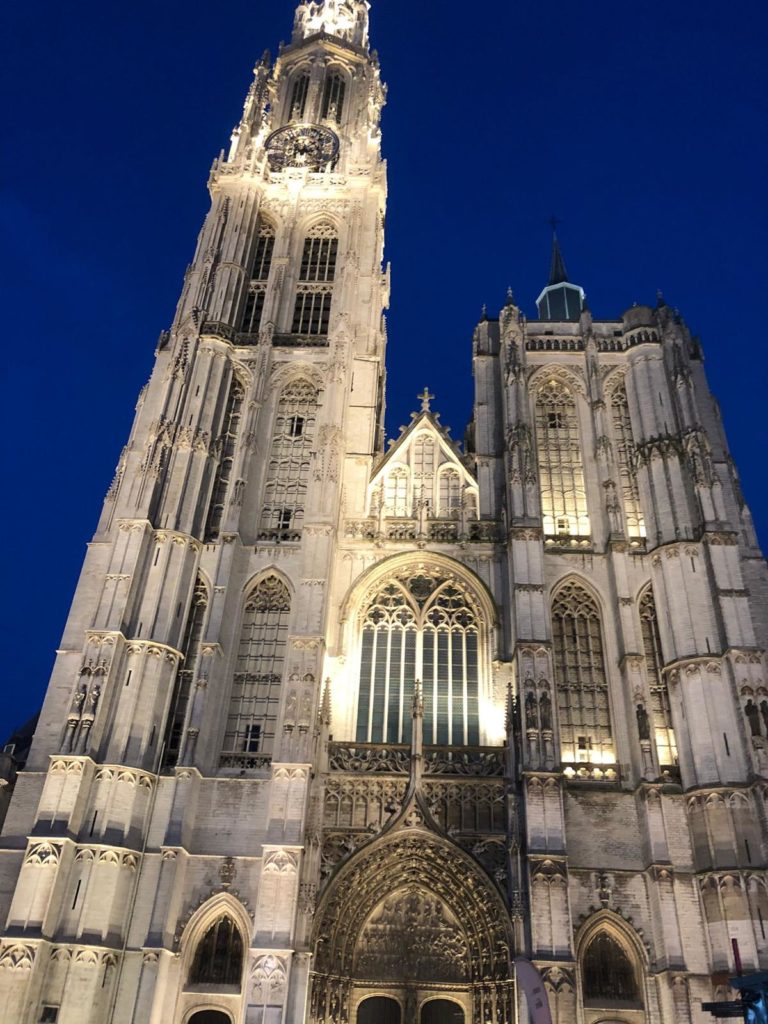
Rubens was also much in evidence at Museum Plantin-Moretus, a 35 room, 450 year old print house where we marvelled at the ancient printing presses, the miniscule type, the books that were published and the vast libraries within. Many of the rooms were lined in golden leather, somewhat faded and dark now but good insulation still! I will never look at Garamond or Times New Roman or other fonts in the same way again now I know who designed them and how they were originally used.
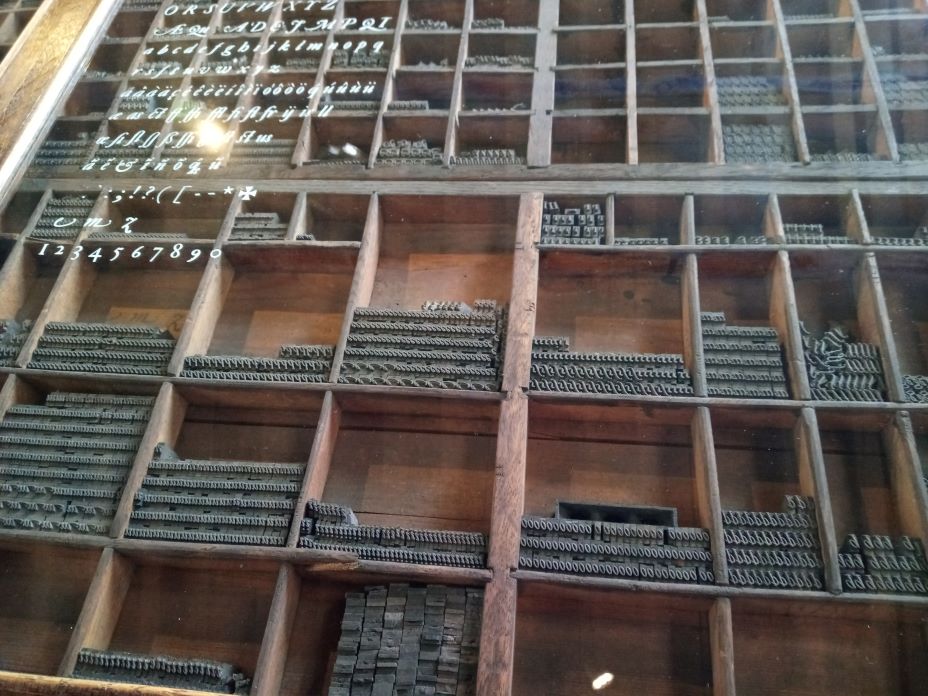
Looking for a light snack near our hotel one evening, we stumbled on a little bar where a very loud punk band had cranked up the volume. It’s well known that Sinjoren (Antwerp’s inhabitants) love to enjoy themselves and love a beer so we stayed and enjoyed the atmosphere too.
Tomorrow it’s off to “Old Blighty” on the Eurostar, after nearly a week amongst the Belgians, a hospitable and friendly nation. Three countries full of history, all very different but all very European in just over 3 weeks.
Week 2 – Switzerland!
Tony was writing this as the temperature hovered around 7 or 8 degrees, although we have had mid-teens at times during our stay in Lucerne. The railway journey up to Milan and across the border into Switzerland with Eurail passes went fairly smoothly, all connections were on time, and we had comfortable seats and didn’t have to actually run to get to the next connection, much to Sally’s relief! It’s about 40 years since we were last in Milan and travelled by rail then direct to London. It was early 1982 and we were making our way back to England to get married after an over land trip through Asia from Sydney to Athens. Tony was so sick with hepatitis he has no memory of post Nepal travel.
Lucerne was our choice of a Swiss base due to its central location and proximity to lakes, mountains and other cities. We stayed at the Hotel Central only 5 minutes’ walk from the train station and have made good use of the Swiss railway (SSB) and its great network. Another great hotel/BB with a larger room, great breakfast buffet and very friendly and helpful staff. We recommend Hotel Central very highly. Another great feature of Swiss railway stations is the co-location of Coop Supermarkets, cafes, chemists and other food outlets so you will never go hungry and can always find a ready-made meal to have a lower cost dinner or snack. Finding Gluten free/dairy free options is a bit more taxing and all the wonderful varieties of breads, pastries and cheeses are very tempting indeed – Sally has managed to limit herself to just one apricot tart so far and there is always salad!
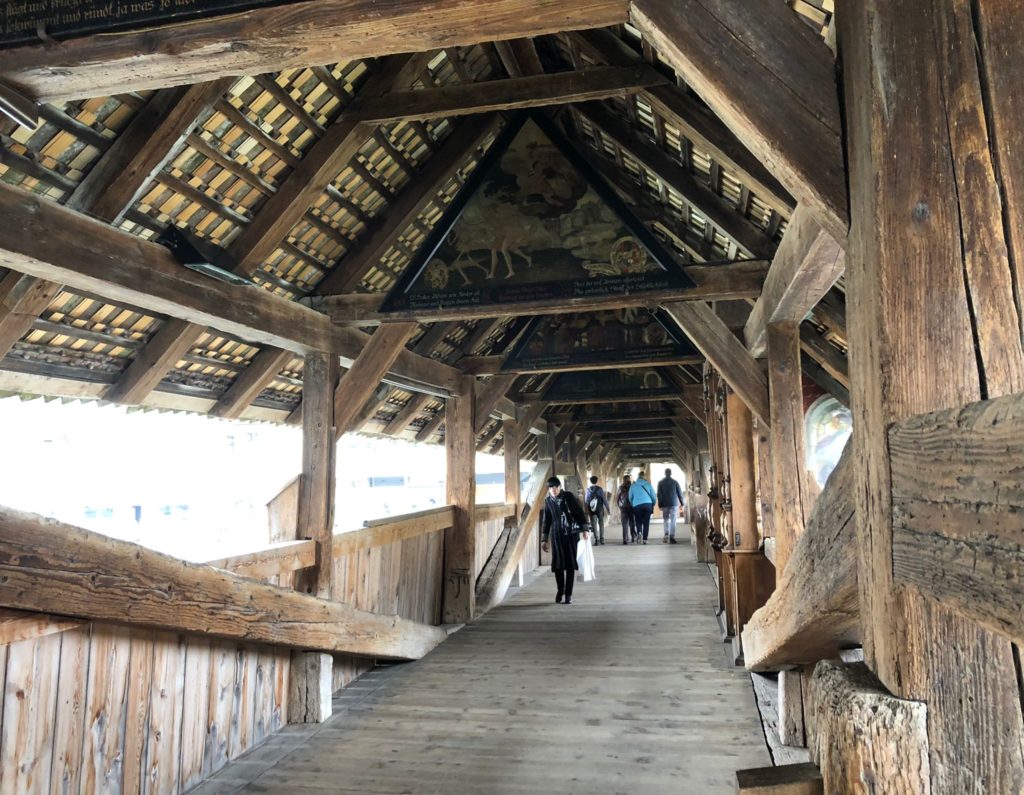
When Sam warned us about how expensive the country was, we were a bit sceptical because Perth’s cost of living is certainly “up there”. But Switzerland is in a different league altogether, no wonder the average wage is as high as it is – $10 for a cup of tea! Veal Meatloaf for dinner one night, a kebab on another. We’re staying in a bed and breakfast so it’s “stock up for the day” in the morning.
Checking out the weather forecast when we arrived in Lucerne, we correctly ascertained that the first day was going to be the only one with any real sunshine so that was our day to get up to Jungfraujoch. It turned out to be one of those magical travel days when everything falls into place. We must have changed trains at least eight times as well as getting two buses and it went so smoothly, we even had time to have a late lunch in Interlaken before returning to Lucerne.
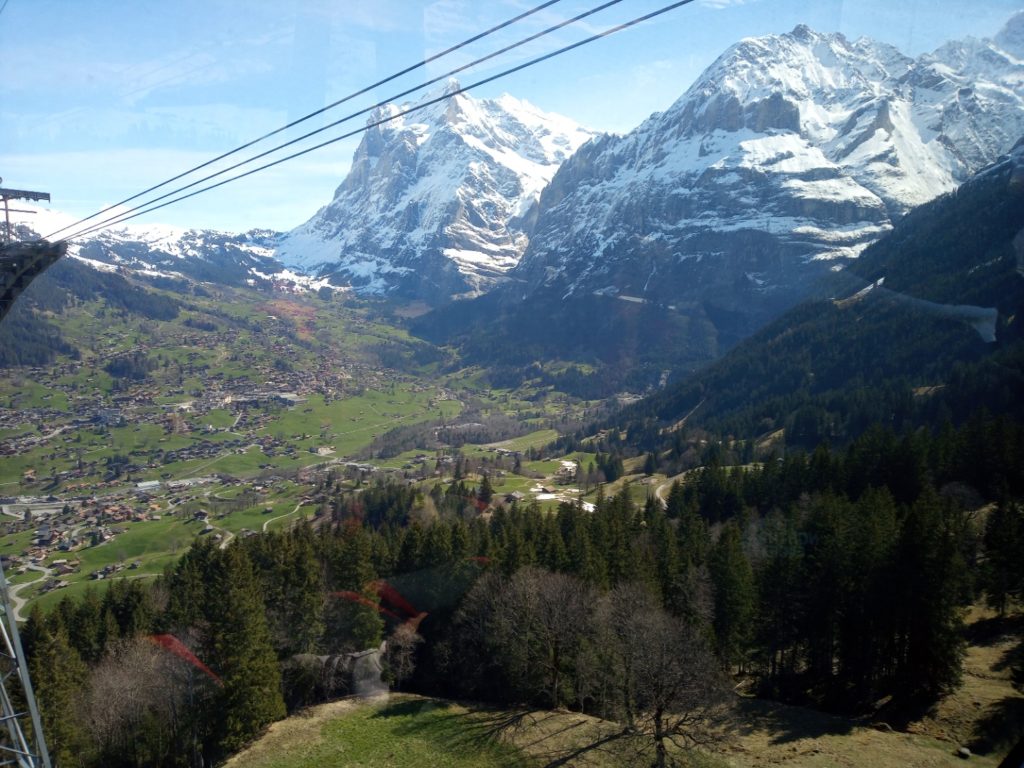
The highlight was undoubtedly the Eiger express tri-cable gondola which whisks you up 2328 metres from Grindelwald to the top of the Eiger glacier in about 20 minutes. Tony also took the final lift up to the summit of Jungfraujoch, 3454 metres. Snow packed hard after six months’ winter was just like walking on a mound of packed corrugated cardboard, but the bright reflected glare is not something he had experienced in a long time. It was surprising to see the numbers of fellow tourists around Jungfraujoch and in Lucerne in mid-April so it must be heaving by midsummer. The ski season was just finishing last week and there must be a huge crowd in winter too. As the lady at the train station said, you may only do this once in your life, but it is well worth the cost and yes, you get a 25% discount with the Eurail Pass!
Another highlight was visiting the Sammlung Rosengart Collection in Lucerne which has an amazing collection of Picasso drawings and paintings as well as three rooms of Paul Klee and other works.
Booking a long 10 hour, 3 country leg of our rail holiday on an app didn’t give us total confidence of a positive outcome, however a visit to the SSB in Lucerne station resulted in absolute Swiss efficiency and printed seat reservations. Tony has worked out the Europass now and it also gives reductions in some other museums and attractions too.
The Swiss are such terribly agreeable people; no histrionics, friendly, helpful and unhurried and they seem very respectful of their countryside and the citizenry – completely able to switch languages and make you feel welcome at the drop of a hat! Visiting the Landesmuseum in Zurich gave us some sense of the incredible journey the Swiss have been on. 150 years ago it was a Republic completely surrounded by kingdoms. It became a major centre for the Reformation and from that developed into the arts and sciences. It has probably one of the purest forms of present day democracy, represented by 26 cantons or states in a confederation and with local communes allowing very grassroots direct decision making. Approaching the Bunderhaus (Parliament) in Bern seems so low key – no patrolling soldiers or police; it’s sitting beside the river Aare and is perfectly flanked by three banks. Unfortunately, the Swiss were very slow to give women the vote, it was only in 1971!
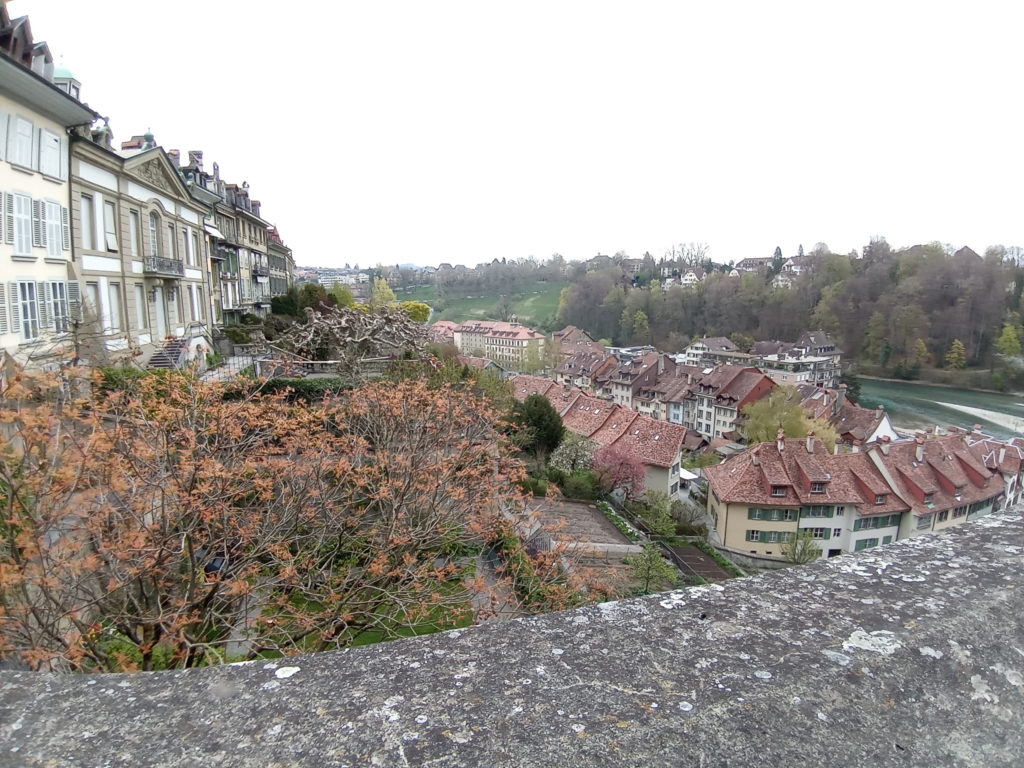
The old towns that have evolved within modern cities -Lucerne, Berne, Zurich are such wonderful little enclaves with Berne’s old town listed as a UNESCO Heritage site. Narrow, winding, cobbled streets with a feel of the 18th and 19th century about them until you realise, they are full of top-end retailing outlets especially jewellery and watch boutiques. We visited Einstein’s House, in Berne and saw the bears at the bear park near the river too. The old buildings are three or four stories high and have steep staircases so Sally is getting nimbler by the day, especially as the toilets often seem to be in the basement and down a couple of flights of steep stairs which make descent a bit more tentative!
Travelling around after our first day of white wonderment we felt a bit disappointed as there was low cloud and mist for the rest of our stay, until the last evening in Lucerne. Coming out of the restaurant, we walked around the corner and Mt Pilatus, 2807 metres, was clearly visible and snow covered as were several other large mountains in a south easterly direction.
Having only fleetingly visited previously we’ve really enjoyed spending a few days with the Swiss in their beautiful country. Our next rail journey is across Germany to Belgium for a 4 day sightseeing visit similar to our visit to Switzerland.
Week 1 Rome
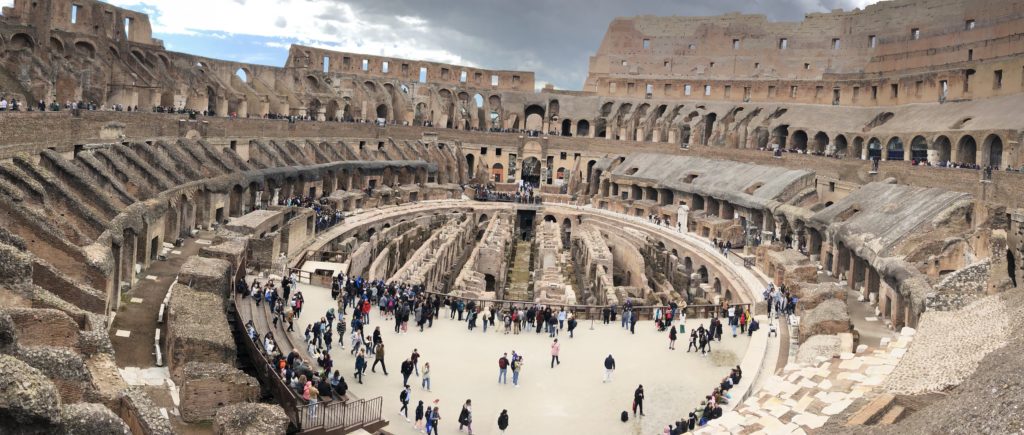
The thought of travelling to Europe again was only really moved from the possible to the definitely probable when the worst of covid had passed. We figured out where we hadn’t been and where we would really like to go and who we had promised to visit. Then with new grandbabies due, our dates were set so we will be home in time to welcome them to the world. That is how we happened to be in Rome the week after Easter amongst the school holiday hordes on the first leg of our 2023 European journey. Our preference is usually for summer or autumn with more predictable warmer and drier weather, but we will be acclimatised for the Perth winter when we return in late May.
We have never fully organised a holiday through a travel agent before but given issues with booking holidays at beginning of Covid and waiting for ages to get refunds, it seemed like a good idea. Thanks to Alex Davey at Houston and Turner Travel Associates in Applecross, we had tickets, Eurail pass, a few hotel reservations and UK car rental, and we flew to Rome via Doha (Qatar) on Easter Monday night. Having experienced Florence in the height of summer we knew what to expect, we thought, although we hadn’t reckoned on the huge numbers of school groups escorted by their teachers along with families of French, German and English school children on a week’s post Easter break with lots of American visitors too.
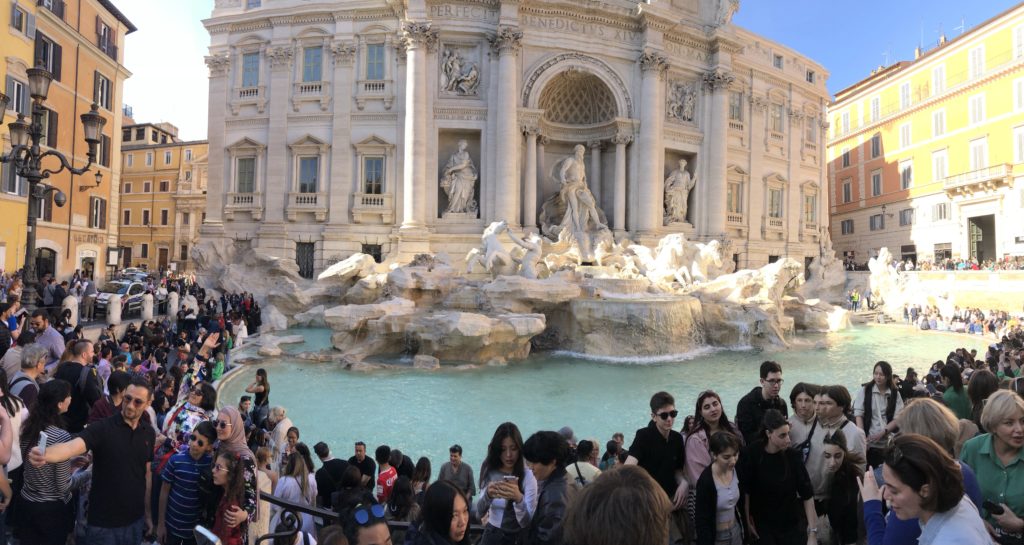
In Rome, everyone visits the Vatican and Ancient Rome and then there’s the Trevi Fountain and the Spanish Steps. We recommend pre-booking some tours to the major sites. Our hotel, Hotel Manfredi Suites on Via Margutti is so well situated near the Spagna metro station and restaurants. The staff are friendly and the breakfast buffet is amazing! The first afternoon we got some sunlight to reduce jetlag by reconnoitring the metro, climbed the Spanish steps, patrolled by the tourist police with their whistles to stop you sitting down, and felt very at ease just surveying the scenes despite the crowds and the brand new surroundings.
Wednesday, we checked out the main railway station for our exit to Switzerland next week, travelled across town via the metro system of two intersecting lines and visited a few of the many Roman churches. Then we just wandered down Via del Corso in the main upmarket shopping district on a beautiful warm spring day towards the Pantheon. We soon remembered that Roman cafes don’t serve just coffee after about 11.30 only lunch and we ate outside in sight of the mighty Dome and the queues of visitors who all magically disappeared when it was our turn to enter. Timing is everything!
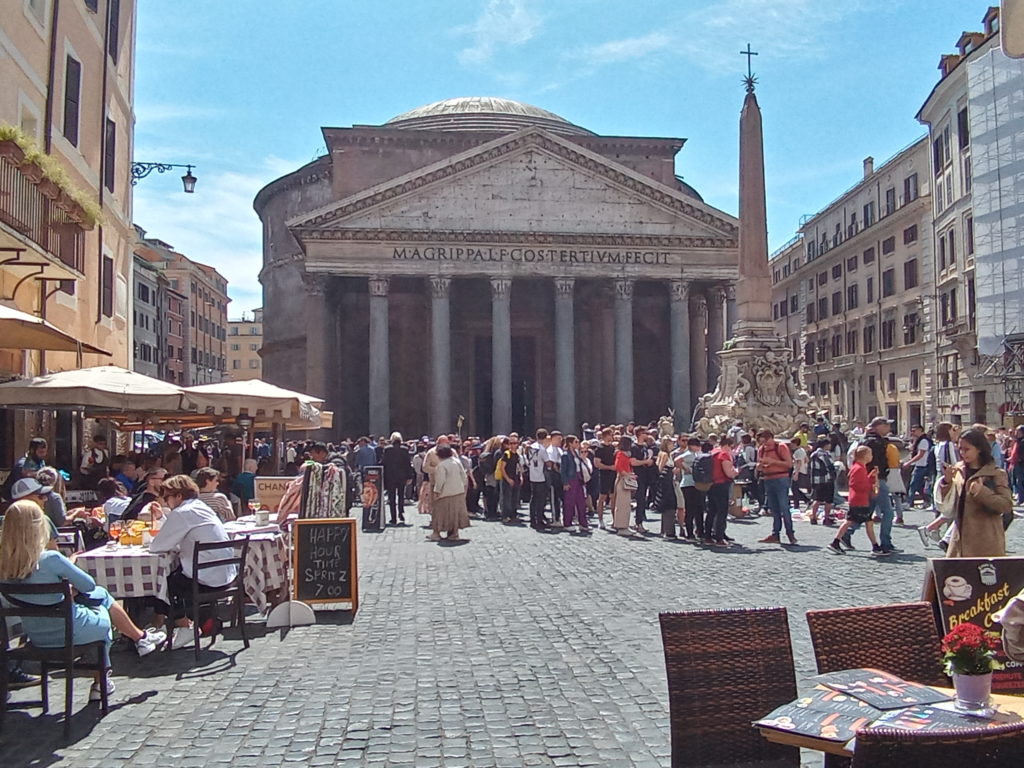
If we had visited St Peters or the Colosseum beforehand, we may not have rated the Pantheon as highly but we were very impressed by its size and architectural achievements considering it was completed by Hadrian in 125 AD and is the only ancient Roman building that has remained practically intact through the centuries. Rome’s streets are narrow and paved with cobbles, designed for slowly wandering and avoiding close contact with small vehicles and we soon found the Galleria Doria Pamphilj a rococo palace whose owners filled it with works of late renaissance art, so full in fact that we were craning our necks to see everything and after an hour or so were pretty saturated by the vast collection that covered walls and ceilings in every room.
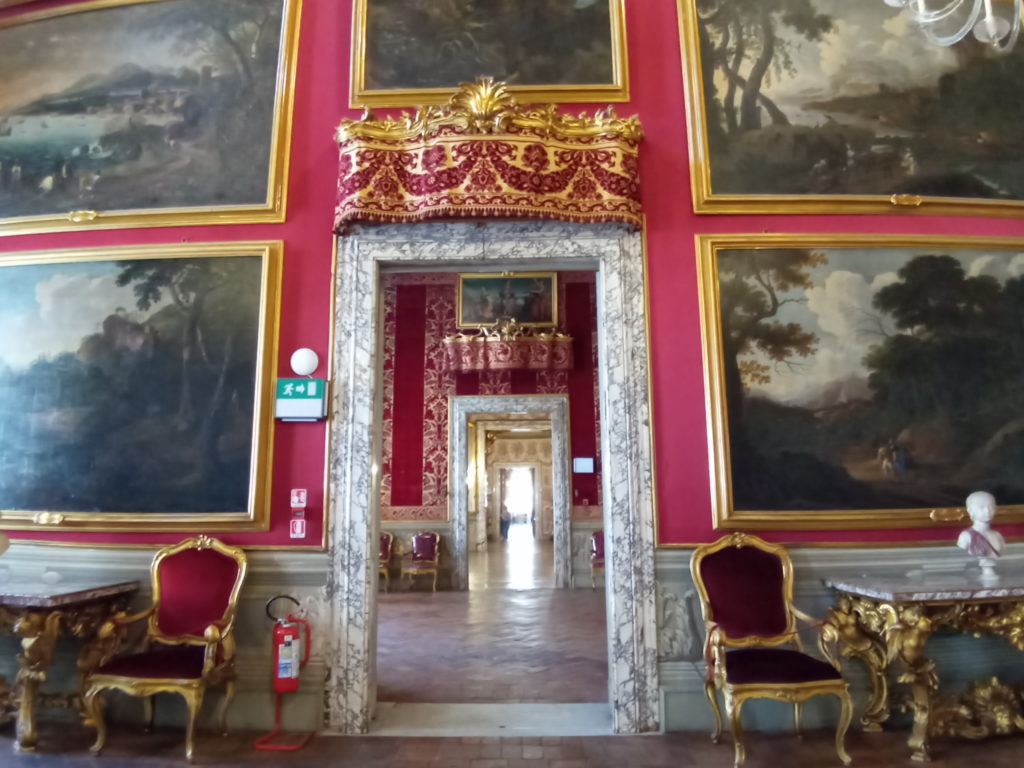
Rome is the city of churches, of course, and on the way back to our hotel we walked into a couple more of them. Every block seems to have a large church or Basilica, often with a Caravaggio or Raffaello painting or a Bernini sculpture and intricate decorations in the various side chapels and ceilings.
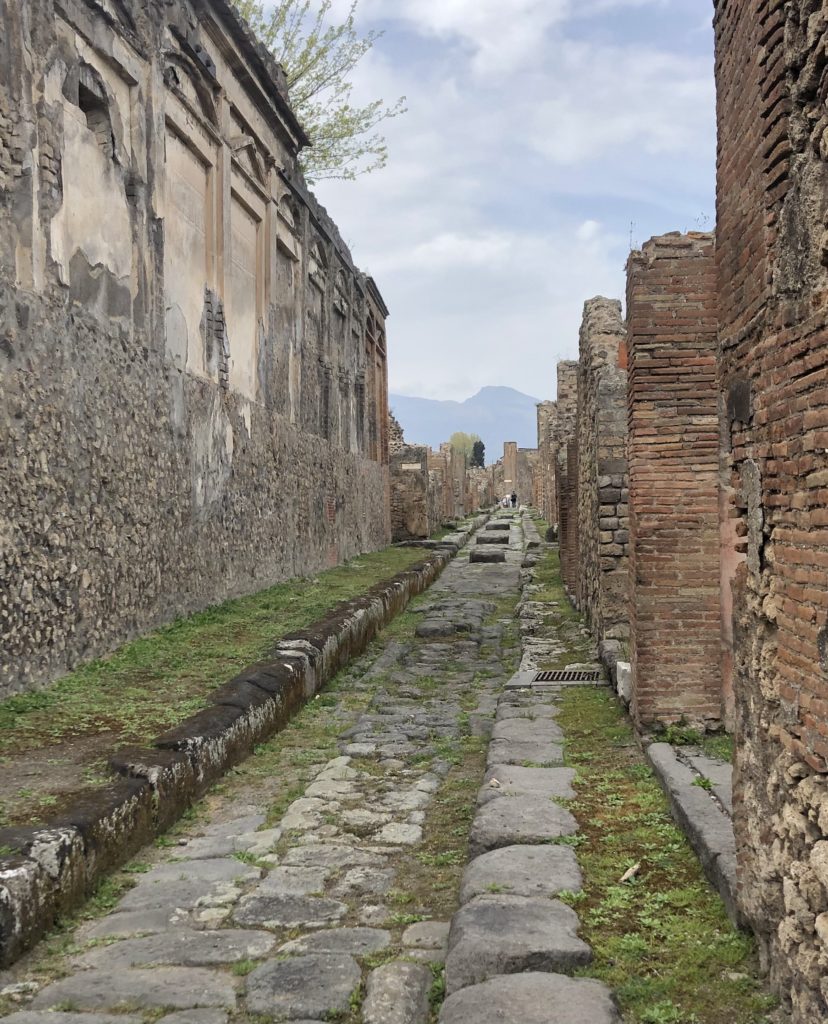
On Thursday, we took a day trip south by bus to see Pompeii, about 220 kilometres on the autostrade via a side drive around Naples. To see Naples from a bus is probably not a very sensual experience given the traffic jams due to roadworks. Pompeii on the other hand was outstanding, a vast city uncovered from Vesuvius’ ashes and lava. It was another warm spring day, almost hot, and we enjoyed our three hour walk around the ancient city streets. The long 13 hour day was made a bit easier by the experienced bus driver, an understated guide, Guillermo, and a wonderful meal near the hotel afterwards.
On Friday, we got the metro to Colloseo station where we wandered near the Roman ruins for a couple of hours. The Basilica dei Santa Cosma e Damieno has a wonderful large mosaic behind the altar. Darkening skies foretold the appearance of a large weather front that lasted the next 36 hours almost flooding some parts of the city. We managed to stay out of the worst of it sheltering in a cafe and then within the Colosseum itself.
Only when walking around the vast spaces of the Roman arena and hearing how Romans enjoyed the bloody spectacles do you get a real sense of this amazing ancient space. The arena floor was covered with a wooden stage allowing the blood and gore to be washed away and the lift arrangement operated by 8 slaves brought animals and human victims up from underneath. We were fortunate to have a very patient and knowledgeable guide as the Forum and Palatine Hill are easy places to get disorientated.
Returning to the metro was a mission due to the rain and crowds and the fact we hadn’t pre purchased our train tickets. Our evening meal was in a wonderful restaurant Museo Atelier Canova Tadolini, in Via del Babuino, where we were surrounded by a variety of sculptures, busts and figures both large and interesting.
On our second last day in Rome, on Saturday, we’d booked a Vatican tour. it was extra busy we think as the Vatican museums are closed on the sabbath. The rain arrived early and hung around all day and was torrential at times leaving us dripping. Giving ourselves plenty of time we had nearly an hour to spend bartering with Senegalese hawkers and visiting bookstore toilet facilities. the tour itself turned out to be a bit disappointing mainly due to speed of the visit due to the immense crowds (estimated at over 14,000 a day to see the Vatican Museums and the Sistine Chapel) and the horrendous weather. However, we got to spend an hour in Saint Peter’s Basilica afterwards and marvelled at its size and grandeur and the relative quiet after our previous three hour tour. The Vatican museums were so full of people it was impossible to look and ponder except to reflect on the vast quantities of valuable art booty stored here. Booking a tour is definitely the best way to see the Vatican as the lines of people queued up to get in individually were huge and extended around St Peters Square in the rain. After spending half a day in a city state of only 900 souls we were left to reflect on the churches inability to share some of its vast wealth more evenly.
Returning to our hotel sodden and sick of the rain, we were able to enjoy pizza and a glass of Italian vino in the warmth.
Sunday was altogether a more pleasant day with sunny warm weather and the opportunity to wander where we wanted. we walked around the Villa Borghese, a large public park close to our hotel and then we visited the Galleria Nazionale d’Arte Moderna and thoroughly enjoyed the change from Renaissance and Roman art. With an amazing collection of paintings, sculpture and installations, we spent a good couple of hours wandering the many rooms with few other visitors, a change from the last couple of days. Wandering back through the park we got good views of the city from the terrace of Villa Medici and had lunch in a crowded cobbled street near our hotel where the passing traffic brushed close to our table.
Roma has been everything we had hoped and planned for a magical city with so much to see and do. staying six nights in a lovely part of the city has meant we’ve been able to explore more than just the major sites. Tomorrow we set off by rail to Switzerland for a week in Lucerne.
